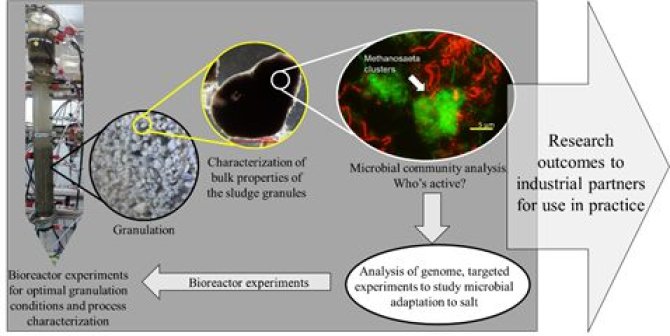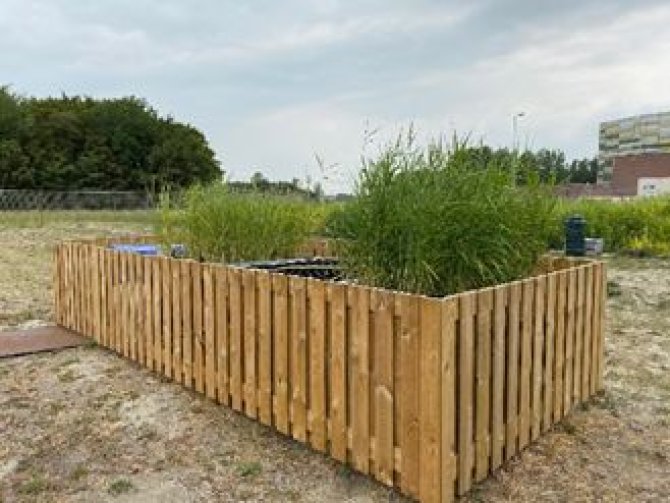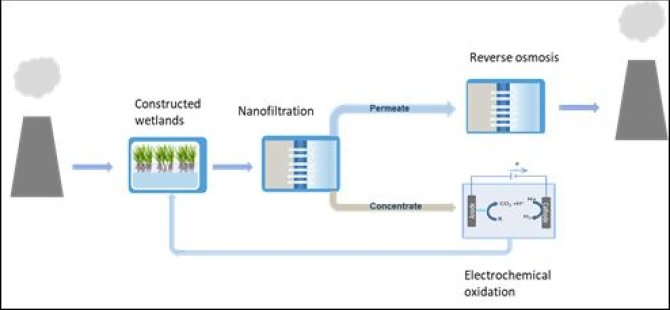Salt and urban water as a resource (ETM)
Summary
Fresh water shortage increasingly damages industrial, agricultural and drinking water sectors and ecosystems, especially in delta areas suffering from droughts. For the past five years, ETM researchers have led the Water Nexus consortium of industries, other stakeholders and universities to help industries use treated salt wastewater and brackish groundwater. Modelling tools were designed to support circular water management and sustainable extraction of brackish water from subsurfaces. A treatment train was developed for highly saline industrial effluent rich in organic material, and another for treating moderately saline wastewater and reusing treated water in industry. Seven ETM PhD and Postdoc researchers obtained scientific insights into mechanisms underlying water treatment technologies and water grid models, now used in practice and reported in 30 scientific publications and 40 BSc/MSc graduation theses.
Approach
In a co-creative way, industries, other stakeholders and scientists selected three domains demanding new knowledge and tools to enable water’s use and re-use: (i) modelling tools; (ii) treatment of high amounts of organics and (iii) treatment of low amounts of organics.
1. Modelling tools
Here, the fresh water scarce region of Zeeuws-Vlaanderen (The Netherlands) is the case. A toolbox was developed to model and design alternative water grids. One tool connects available water sources, including brackish groundwater, with water users, considering water quantity and quality requirements, with limits for extraction taken into account to prevent salt water intrusion and damage to nature. Local decentralised water supply networks were designed, connecting users with fresh and brackish groundwater sources (Fig. 1). The second tool designs water treatment trains based on water quality requirements of users and quality of available sources.

2. Treatment of saline industrial wastewaters with high amounts of organics
Agro-industrial-generated wastewaters often contain high concentrations of salt and dissolved organic materials. A sustainable removal approach is applying compact anaerobic bioreactors wherein microorganisms convert organic pollutants into energy-rich biogas. However, salts negatively impact microorganism activity, hampering saline water anaerobic treatment. The ETM team proved these two problems can be resolved by tuning process conditions of lab-scale reactors at ETE and linking reactor performance with a thorough analysis of microbial communities developing them by MIB (Fig. 2). Results are implemented at two full-scale treatment plants operating in cooperation with technology developers Paques, Nijhuis Industrial Technologies and Royal Haskoning-DHV.

3. treatment of saline industrial waste waters with low amounts of organics
During cooling, water is sprayed on top of a cooling tower and largely evaporates; remaining water at the bottom is enriched in salt. To make this wastewater reusable by desalination, industrial conditioning chemicals and natural organic compounds must be removed. A constructed wetland was tested at ETM, followed by an on-site pilot next to Terneuzen’s DOW Benelux cooling tower (Fig 3). All other technologies needed were subsequently tested and put in a process flow sheet (Fig. 4).


This process scheme is further investigated for industrial application and for ‘greening the desert’ programmes in the Middle East in collaboration with Shell and local universities.
Stakeholder interactive research and education
We aim to educate PhD, MSc and BSc students on how to execute high-level research in conjunction with stakeholders for high societal impact. With PhD’s, Postdocs and stakeholders, we organised so-called design studio workshops during the Water Nexus Project.
Our approach took water footprint reduction and water re-use needs of large industrial water users (DOW Benelux and Shell) and drinking water companies (Evides Industrial Water and Oasen) as a starting point. For water treatment technology development, we collaborated with technology providers (Paques, Nijhuis Technologies, Magneto, Plant-E). The translation of scientific insights to broader application of modelling and blueprint concepts was facilitated by consultancy companies (Witteveen+Bos, RoyalHaskoning-DHV) and research institutes (Deltares, TNO, KWR-Water). Governmental organisations (Ministry of Infrastructure and Water Management), provinces and water authorities provided insight into the legal and administrative boundaries for implementing new technologies in future water management blueprints.
Outreach
The modelling tool box and water treatment were recognised by 37 stakeholders as important instruments for making the Netherlands drought-resilient. This recognition appeared in support for the new, awarded NWO TTW Perspectief grant AquaConnect (www.aquaconnect.nu). The technologies for treatment and decision-making frameworks for regional water extraction, transport and local treatment in Zeeuws-Vlaanderen are being adopted by local stakeholders. These results are translated abroad in projects in Vietnam, the Barapullah drain in New Delhi, greening the desert programmes in Oman, Qatar and Khulna (in Bangladesh) (Fig. 5).

References: Peer-reviewed scientific publications involving ETM researchers resulting from the programme Water Nexus
Bianchi, A. B., Wreyford, J. M., Willet, J., Gerdessen, J. C., Dykstra, J. E., and Rijnaarts, H. H. M. (2021) Treatment vs. transport: A framework for assessing the trade-offs between on-site desalination and off-site water sourcing for an industrial case study. Journal of Cleaner Production, 285, 124901. [online] https://www.sciencedirect.com/science/article/pii/S0959652620349453.
Brüninghoff, R., van Duijne, A. K., Braakhuis, L., Saha, P., Jeremiasse, A. W., Mei, B., and Mul, G. (2019) Comparative Analysis of Photocatalytic and Electrochemical Degradation of 4-Ethylphenol in Saline Conditions. Environmental Science & Technology, 53(15), 8725–8735. [online] https://doi.org/10.1021/acs.est.9b01244.
Gagliano, M. C., Sudmalis, D., Pei, R., Temmink, H., and Plugge, C. M. (2020) Microbial Community Drivers in Anaerobic Granulation at High Salinity. Frontiers in Microbiology, 11, 235. [online] https://www.frontiersin.org/article/10.3389/fmicb.2020.00235.
Gagliano, M. C., Sudmalis, D., Temmink, H., and Plugge, C. M. (2020) Calcium effect on microbial activity and biomass aggregation during anaerobic digestion at high salinity. New Biotechnology, 56, 114–122. [online] https://www.sciencedirect.com/science/article/pii/S1871678419301189.
Gagliano Maria C., Neu, T. R., Kuhlicke, U., Sudmalis, D., Temmink, H., and Plugge, C. M. (2018) EPS Glycoconjugate Profiles Shift as Adaptive Response in Anaerobic Microbial Granulation at High Salinity. Frontiers in Microbiology, 9, 1423.
Saha, P., Bruning, H., Wagner, T. V, and Rijnaarts, H. H. M. (2020) Removal of organic compounds from cooling tower blowdown by electrochemical oxidation: Role of electrodes and operational parameters. Chemosphere, 259, 127491. [online] https://www.sciencedirect.com/science/article/pii/S0045653520316854.
Saha, P., Wagner, T. V, Ni, J., Langenhoff, A. A. M., Bruning, H., and Rijnaarts, H. H. M. (2020) Cooling tower water treatment using a combination of electrochemical oxidation and constructed wetlands. Process Safety and Environmental Protection, 144, 42–51. [online] https://www.sciencedirect.com/science/article/pii/S0957582020316207.
Sudmalis, D., Gagliano, M. C., Pei, R., Grolle, K., Plugge, C. M., Rijnaarts, H. H. M., Zeeman, G., and Temmink, H. (2018) Fast anaerobic sludge granulation at elevated salinity. Water Research, 128, 293–303. [online] https://www.sciencedirect.com/science/article/pii/S0043135417308758.
Sudmalis, D., Millah, S. K., Gagliano, M. C., Butré, C. I., Plugge, C. M., Rijnaarts, H. H. M., Zeeman, G., and Temmink, H. (2018) The potential of osmolytes and their precursors to alleviate osmotic stress of anaerobic granular sludge. Water Research, 147, 142–151. [online] https://www.sciencedirect.com/science/article/pii/S0043135418307917.
Sudmalis, D., Mubita, T. M., Gagliano, M. C., Dinis, E., Zeeman, G., Rijnaarts, H. H. M., and Temmink, H. (2020) Cation exchange membrane behaviour of extracellular polymeric substances (EPS) in salt adapted granular sludge. Water Research, 178, 115855. [online] https://www.sciencedirect.com/science/article/pii/S0043135420303924.
Wagner, T. V., Helmus, R., Becker, E., Rijnaarts, H. H. M., De Voogt, P., Langenhoff, A. A. M., and Parsons, J. R. (2020) Impact of transformation, photodegradation and interaction with glutaraldehyde on the acute toxicity of the biocide DBNPA in cooling tower water. Environmental Science: Water Research and Technology, 6(4), 1058–1068.
Wagner, T. V., Parsons, J. R., Rijnaarts, H. H. M., de Voogt, P., and Langenhoff, A. A. M. (2018) A review on the removal of conditioning chemicals from cooling tower water in constructed wetlands. Critical Reviews in Environmental Science and Technology, 48(19–21), 1094–1125. [online] https://doi.org/10.1080/10643389.2018.1512289.
Wagner, T. V, Al-Manji, F., Xue, J., Wetser, K., de Wilde, V., Parsons, J. R., Rijnaarts, H. H. M., and Langenhoff, A. A. M. (2021) Effects of salinity on the treatment of synthetic petroleum-industry wastewater in pilot vertical flow constructed wetlands under simulated hot arid climatic conditions. Environmental Science and Pollution Research, 28(2), 2172–2181. [online] https://doi.org/10.1007/s11356-020-10584-8.
Wagner, T. V, Helmus, R., Quiton Tapia, S., Rijnaarts, H. H. M., de Voogt, P., Langenhoff, A. A. M., and Parsons, J. R. (2020) Non-target screening reveals the mechanisms responsible for the antagonistic inhibiting effect of the biocides DBNPA and glutaraldehyde on benzoic acid biodegradation. Journal of Hazardous Materials, 386, 121661. [online] https://www.sciencedirect.com/science/article/pii/S0304389419316152.
Wagner, T. V, Parsons, J. R., Rijnaarts, H. H. M., Voogt, P. De, and Langenhoff, A. A. M. (2020) Benzotriazole removal mechanisms in pilot-scale constructed wetlands treating cooling tower water. Journal of Hazardous Materials, 384(July 2019), 121314.
Wagner, T. V, de Wilde, V., Willemsen, B., Mutaqin, M., Putri, G., Opdam, J., Parsons, J. R., Rijnaarts, H. H. M., de Voogt, P., and Langenhoff, A. A. M. (2020) Pilot-scale hybrid constructed wetlands for the treatment of cooling tower water prior to its desalination and re-use. Journal of Environmental Management, 271, 110972. [online] https://www.sciencedirect.com/science/article/pii/S0301479720309002.
Willet, J., King, J., Wetser, K., Dykstra, J. E., Oude Essink, G. H. P., and Rijnaarts, H. H. M. (2020) Water supply network model for sustainable industrial resource use a case study of Zeeuws-Vlaanderen in the Netherlands. Water Resources and Industry, 24, 100131. [online] https://www.sciencedirect.com/science/article/pii/S221237172030024X.
Willet, J., Wetser, K., Vreeburg, J., and Rijnaarts, H. H. M. (2019) Review of methods to assess sustainability of industrial water use. Water Resources and Industry, 21, 100110. [online] https://www.sciencedirect.com/science/article/pii/S2212371718300404.
Wreyford, J. M., Dykstra, J. E., Wetser, K., Bruning, H., and Rijnaarts, H. H. M. (2020) Modelling framework for desalination treatment train comparison applied to brackish water sources. Desalination, 494, 114632. [online] https://www.sciencedirect.com/science/article/pii/S0011916420313102.
Global outreach projects where technology trains with wetland components are developed
- Water Nexus (https://waternexus.nl/)
- Entire (https://www.nwo.nl/en/projects/w-0769202)
- LOTUSHR (https://lotushr.org/)
- Water2Rice project of Kamonishish Haldar (https://www.wur.nl/en/Research-Results/Research-programmes/International-programmes/Asia/Bangladesh.htm)
- Greening the Desert (https://www.shell.com/about-us/major-projects/pearl-gtl/producing-water-in-the-desert.html; https://www.shell.com/inside-energy/oman-reed-beds-nature.html#vanity-aHR0cHM6Ly93d3cuc2hlbGwuY29tL3N1c3RhaW5hYmlsaXR5L2Vudmlyb25tZW50L3dhdGVyL2EtbmF0dXJhbC1maWx0ZXItZm9yLXdhdGVyLXRoZS1uaW1yLXJlZWQtYmVkcy5odG1s)
- AquaConnect >> NWO/Min EZ website 10th of March; www.aquaconnect.nu